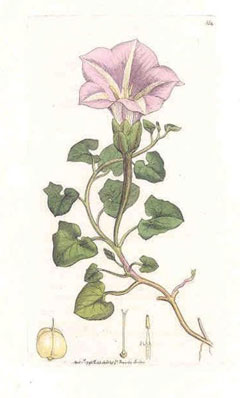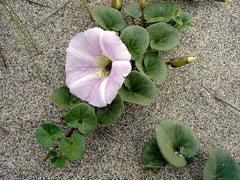 |
|
http://commons.wikimedia.org/wiki/File:SowerbySeaBindWeed.jpg |
 |
| http://commons.wikimedia.org/wiki/User:Jeantosti |
Translate this page:
Summary
Physical Characteristics

 Calystegia soldanella is a PERENNIAL CLIMBER growing to 0.6 m (2ft).
Calystegia soldanella is a PERENNIAL CLIMBER growing to 0.6 m (2ft).
See above for USDA hardiness. It is hardy to UK zone 6. It is in flower from June to August. The species is hermaphrodite (has both male and female organs) and is pollinated by Bees, Lepidoptera (Moths & Butterflies).
Suitable for: light (sandy), medium (loamy) and heavy (clay) soils. Suitable pH: mildly acid, neutral and basic (mildly alkaline) soils. It cannot grow in the shade. It prefers moist soil.
UK Hardiness Map
US Hardiness Map
Synonyms
Convolvulus soldanella.
Plant Habitats
Cultivated Beds;
Edible Uses
Edible Parts: Leaves Shoots
Edible Uses:
Young shoots - cooked as a vegetable or pickled and used as a samphire substitute[2, 105]. Caution is advised since the plant might have a purgative effect[173].
References More on Edible Uses
Medicinal Uses
Plants For A Future can not take any responsibility for any adverse effects from the use of plants. Always seek advice from a professional before using a plant medicinally.
Antiscorbutic Diuretic Febrifuge Irritant Purgative Vermifuge
Antiscorbutic, diuretic, febrifuge, irritant, purgative and vermifuge[218].
References More on Medicinal Uses
The Bookshop: Edible Plant Books
Our Latest books on Perennial Plants For Food Forests and Permaculture Gardens in paperback or digital formats.

Edible Tropical Plants
Food Forest Plants for Hotter Conditions: 250+ Plants For Tropical Food Forests & Permaculture Gardens.
More

Edible Temperate Plants
Plants for Your Food Forest: 500 Plants for Temperate Food Forests & Permaculture Gardens.
More

More Books
PFAF have eight books available in paperback and digital formats. Browse the shop for more information.
Shop Now
Other Uses
String
The stems are very flexible and are used as a string for tying[66]. Fairly strong but not long-lasting[K].
Special Uses
References More on Other Uses
Cultivation details
Easily grown in ordinary well-drained garden soil in a sunny position[1, 200]. This species is very difficult to establish successfully in the garden[1].
References Carbon Farming Information and Carbon Sequestration Information
Temperature Converter
Type a value in the Celsius field to convert the value to Fahrenheit:
Fahrenheit:
The PFAF Bookshop
Plants For A Future have a number of books available in paperback and digital form. Book titles include Edible Plants, Edible Perennials, Edible Trees,Edible Shrubs, Woodland Gardening, and Temperate Food Forest Plants. Our new book is Food Forest Plants For Hotter Conditions (Tropical and Sub-Tropical).
Shop Now
Plant Propagation
Seed - sow spring in a cold frame in a free draining compost and only just cover. The seed usually germinates in 1 - 3 months at 15°c[138]. When they are large enough to handle, prick the seedlings out into individual pots and grow them on in a cold frame for at least their first winter. Plant them out into their permanent positions in late spring or early summer, after the last expected frosts. Division in early spring whilst dormant[200].
Other Names
If available other names are mentioned here
Native Range
TEMPERATE ASIA: Iran (north), Lebanon, Turkey, Georgia, Russian Federation (Kurile Islands (south)), China (Fujian Sheng, Hebei Sheng, Liaoning Sheng, Shandong Sheng, Zhejiang Sheng), Korea, Japan (Hokkaidô, Honshu, Kyushu, Ryukyu Islands, Shikoku), Taiwan NORTHERN AMERICA: Canada (British Columbia (west)), United States (Oregon (west), Washington (west), North Carolina (east), California (west)) SOUTHERN AMERICA: Ecuador (Galápagos), Argentina (Buenos Aires), Chile, Uruguay AUSTRALASIA: Australia (Tasmania, New South Wales (east), Queensland (southeast), Victoria), New Zealand EUROPE: Denmark, United Kingdom, Ireland, Belgium, Germany, Netherlands, Ukraine (Krym), Albania, Bulgaria, Bosnia and Herzegovina, Greece (incl. Crete), Italy (incl. Sardinia, Sicily), Malta, Slovenia, Spain (incl. Baleares), France (incl. Corsica), Portugal AFRICA: Algeria (north), Morocco, Tunisia, South Africa (Western Cape)
Weed Potential
Right plant wrong place. We are currently updating this section.
Please note that a plant may be invasive in one area but may not in your area so it's worth checking.
Conservation Status
IUCN Red List of Threatened Plants Status :

Growth: S = slow M = medium F = fast. Soil: L = light (sandy) M = medium H = heavy (clay). pH: A = acid N = neutral B = basic (alkaline). Shade: F = full shade S = semi-shade N = no shade. Moisture: D = dry M = Moist We = wet Wa = water.
Now available:
Food Forest Plants for Mediterranean Conditions
350+ Perennial Plants For Mediterranean and Drier Food Forests and Permaculture Gardens.
[Paperback and eBook]
This is the third in Plants For A Future's series of plant guides for food forests tailored to
specific climate zones. Following volumes on temperate and tropical ecosystems, this book focuses
on species suited to Mediterranean conditions—regions with hot, dry summers and cool, wet winters,
often facing the added challenge of climate change.
Read More
Expert comment
Author
(L.)R.Br.
Botanical References
17200
Links / References
For a list of references used on this page please go here
Readers comment
© 2010, Plants For A Future. Plants For A Future is a charitable company limited by guarantee, registered in England and Wales. Charity No. 1057719, Company No. 3204567.